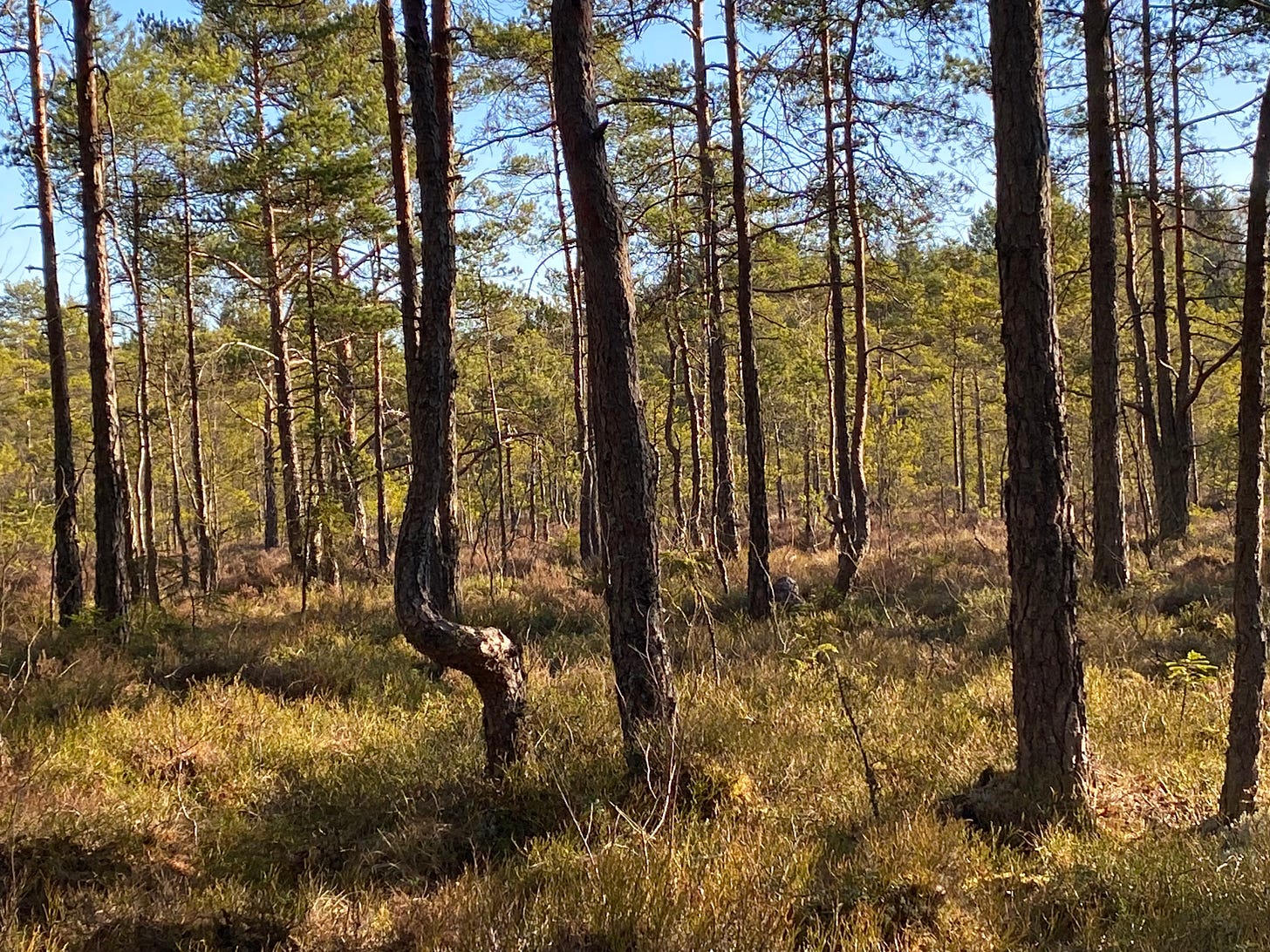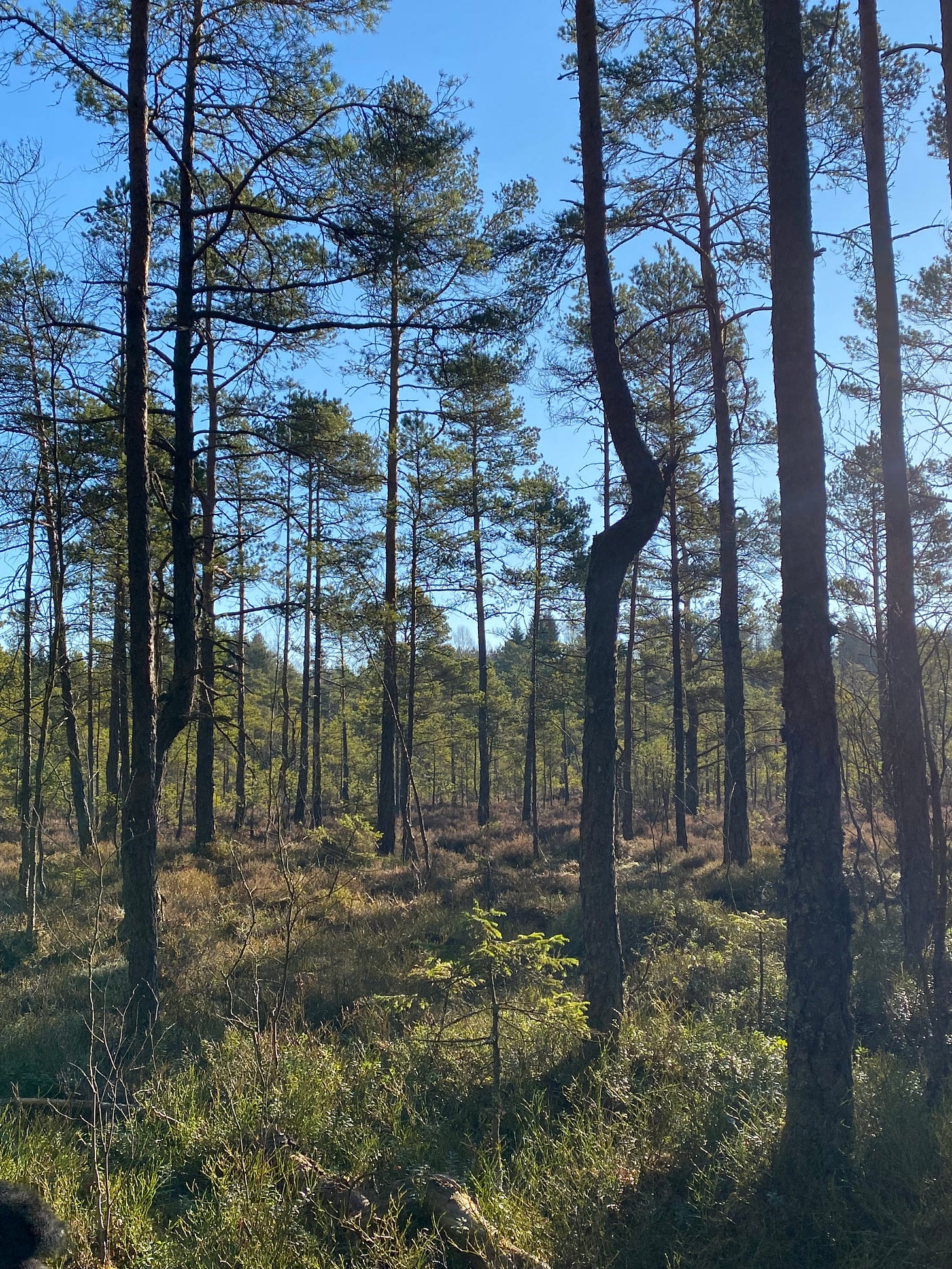Hello Wildlings,
I have had the idea for this newsletter for awhile. The image you see above is of a tree that grows in the mire (the Swedish word is myr,) over the road from my house. There are many of them that grow there, some straight but many, many of them are twisted in the way that you see here and that got me thinking ….
Each morning as I walk through the mire, I feel my feet sink into the soft, spongy soil. Pools of water cover some parts of the path, at other points it is a little dryer but it is always pliant underfoot. The high water content makes the soil acidic and poor in oxygen and nutrients that the trees need to grow. It also prevents the mycorrhizal networks from developing, meaning that the tress cannot communicate with each other or share carbon, (in the form of sugars,) phosphorous (essential for root development, flowering and energy transfer,) and nitrogen (essential for protein synthesis and leaf growth,) as well as other micro-nutrients. The trees need to slow down their growth to survive and so they become twisted and misshapen. Yet still they find a way to survive and grow. Some gnarled pines in the north have lived for hundreds of years. If tenacity had a shape, I feel this would be it.
Some years ago I read about a creative game that was being used to help groups of people understand how early child brain development impacts on later life. It was developed in part by the Center for the Developing Child at Harvard University. When I look at these trees as I walk through the mire, I often think of this game. In it pipe-cleaners, straws and weights are used to build a ‘brain.’ The goal is to build a brain that is as tall as possible, which represents functionality and as sturdy as possible, which represents the ability to withstand stresses. Groups work together, pulling ‘Life Experience Cards’ to get the materials needed for brain building. Positive experiences mean the group will get a pipe-cleaner and a straw to put around it, which makes it stronger. If a negative experience is pulled, the group only get a pipe-cleaner and no straw. Weights must also be hung from the structure to represent stressors that a child can experience. Will the structure be strong enough to bear these stressors or will it crumple and become twisted like the trees in the mire?
As I write this I have a memory tugging at my mind - my daughter is in my arms, she is about 3 months old. I am bending my head down and ‘munching’ her belly. She is smiling and gurgling, suddenly she laughs - her first laugh. It is a bubbling stream of joy. So I munch her belly again and once more she lets out the wren song of laughter. I do it again and again and I am rewarded and she is rewarded again and again. This type of happening between babies and adults is called serve and response. It strengthens and reinforces behaviours.
Babies brains function, in many ways like a mycorrhizal network for just as trees rely on this network to support them before they can thrive on their own, a baby relies on co-regulation - meaning they learn to manage emotions, attention, and stress by being connected to a caregiver’s brain and nervous system. So, you could say that mycorrhizae provide a support system for roots, in the same way that a caregiver provides an emotional and neural support system for the babies developing brain. A child’s brain wires itself through relationships. Eye contact, tone of voice, gentle touch — these stimulate neural growth and create synaptic pathways in the same way that fungal threads grow toward root tips in response to chemical signals.
Munch, munch, munch Laugh, laugh, laugh Growth, growth, growth
Repeated experiences strengthen connections. In humans, neglect or trauma, like poor soil, weakens or distorts growth. Yet I feel it can also create tenacity and resilience. As I sit here now I know that:
Though my growth was twisted, Though there was resistance where there should have been flow, Like the trees, I adapted. I bent, I slowed, I turned toward light when I could find it And I feel myself stronger for it, More nuanced More empathic. Thus am I grateful
In the same way that fungal networks are incredibly plastic and adaptable, so are infant brains - they grow toward opportunity, adapt to their environment, and prune or reinforce connections based on use. In babies, neurons that fire together, wire together and strengthen, in the same way that fungal hyphae grow toward resources and retract when soil becomes inhospitable.
I know, as I sit here and write this that my children came from good, rich, nourishing soil.
I know, as I sit here and write this, that I did not
But
I was nourished within that mire of poverty and struggle by something very powerful - the love of my mother. She was not always able to show it,( for she was in her own mire,) but her love was there, palpable and true.
In her book, Finding the Mother Tree, author and scientist Dr Suzanne Simard explains how in forests there are ‘Mother Trees’ who share their nutrients with their off-spring, enabling them to grow and flourish. My mother did that for me. The mire of my childhood may have caused my lungs to be twisted and my opportunities to be limited but the love of my mother enabled me to continue growing.
The sun is just now shining through the window, I lift my gaze and stare out. The mire beckons me. The twisted trees call me, they know my name and I know theirs for our roots are the same root. I will go and be with them and see what more I can learn to share with you all.
Thank you for reading this.
In tenacious twistedness
Kx







So much to relate to here, both as a child and a parent. And such beautiful photographs. There's always such a deep affinity in me for trees that have given visible form to their struggle to survive. Such beautiful twists and bends and wounds.
But above all: "the wren song of laughter" touched me in a very tender place. What a gorgeous line. I was in the middle of a conversation about wrens with a friend as I read this post.